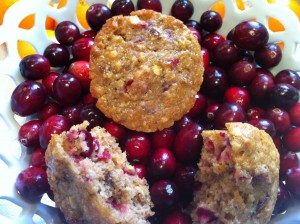New Harvard Study: Eat More Fiber? That Depends…
- At February 15, 2011
- By Katherine
- In News
 0
0
The Harvard study found “dietary fiber may reduce the risk of death from cardiovascular, infectious and respiratory diseases,” published in February 14’s Archives of Internal Medicine. But, this may not mean what you THINK it means!
Should you be looking for foods in your supermarket which exclaim in bright letters “HIGH FIBER?” Probably NOT! Let me explain:
The term “HIGH FIBER DIET” when describing an eating pattern which benefits your health, is more accurately described as “A DIET HIGH IN FOODS WHICH ARE NATURALLY FIBER-RICH.”
What’s the difference? This is a critical, literally life-saving distinction… so read on!
People who eat a diet high in foods which are NATURALLY fiber-rich are the ones who receive the health benefits from a high fiber diet.
That is because foods which are naturally fiber rich are also naturally jam-packed full of vitamins, minerals, antioxidants, and other plant compounds (called “phytonutrients”) which have known health-enhancing benefits. This is the combination of nutrients – including fiber – which makes people healthy… NOT-THE-FIBER-ALONE!
How can you tell the difference and incorporate these findings into your and your family’s everyday routine? Read on…
Our grandmothers have been extolling the virtues of “roughage” for generations. Turns out, they were right. But the benefits of roughage, aka fiber, are far more vast than grandmother ever realized.
The findings from this new Harvard study are not surprising to me. Scientific research has been accumulating for decades that an eating pattern emphasizing plant foods – fruits, vegetables, legumes, whole grains, and nuts – is the healthiest diet on the planet. Plant foods are naturally high in life-saving fiber and other nutrients. They lower inflammation, improve the immune response, reduce risk of many diseases from colds to cancer, cardiovascular disease, type 2 diabetes, and keep us lean. This study is yet another piece of proof rounding out our knowledge.
So, for many reasons, the National Academy of Sciences’ (NAS) Food and Nutrition Board, the group which issues periodic dietary recommendations for Americans, recommends Americans double their daily fiber intake to 38 grams for men and 25 grams for women.
Fiber is mainly carbohydrate, the undigestible part of plant foods (fruits, vegetables, whole grains, legumes, and nuts)– it travels unchanged through the intestines. Fiber comes in many different forms in food. It is concentrated, for instance, in the skin of fruits and vegetables, such as apples, corn, and legumes, the seeds of vegetables and fruits such as berries and cucumbers, and the germ and bran or coating which surrounds wheat kernels and other grains. These essential parts of the grain are removed to create white flour and other refined grains.
Americans eat very little fiber – half of what is recommended, eating a highly refined diet, instead. And if you’re on a low carb diet, you’re lucky to be eating any. There are plenty of great reasons to increase your intake of fiber-rich foods. My clients who do discover multiple benefits.
Easier Weight Loss
Not eating enough fiber may be one reason why people are getting fatter.
A study published in the American Journal of Clinical Nutrition found that women with the highest fiber intake had a 49 percent lower risk of major weight gain compared with women eating less fiber.
High fiber diets are usually lower in calories. Though fiber is mainly carbohydrate, very little of it, if any, is actually digested. So, with foods high in fiber, you’re actually eating food which only partially counts as calories (and you thought that was only in your dreams!).
High fiber foods are also bulky, and often watery foods, which means they fill you up for fewer calories. Studies have shown adding high fiber foods, such as vegetables, before or during a meal decreases the overall calorie content of the meal by about 100. While saving 100 calories a day may not sound like much, it translates into losing ten pounds in one year.
High fiber foods require more chewing and take longer to eat, which leads to more physical and psychological satisfaction with your meals.
Improved Intestinal Function
Digestive disorders are on the rise and a main reason may be the dearth of fiber in our diets. For most digestive disorders such as reflux disease, constipation, diarrhea, hemmorhoids, diverticulitis, ulcerative colitis, Crohn’s disease and irritable bowel syndrome, a higher fiber diet relieves symptoms and can even prevent the disorder in the first place.
Many people with these disorders, particularly Crohn’s disease or diarrhea, think they should avoid fiber, but that’s a mistake for most. Fiber increases bulk and motility and this relieves pressure, keeps everything regular and more comfortable for the whole gammit of intestinal disorders.
Imagine fiber as a dry sponge in your intestinal tract. Fiber pulls water into the system, keeping everything larger, softer and moving more quickly and easily.
Improved Immune Function
The Harvard study found a reduced risk of infectious and respiratory diseases associated with a high fiber diet. This may be because many of the foods containing nutrients instrumental in a healthy immune system happen to be high in fiber. Read more…
Lower Diabetes Risk
Numerous studies have shown that high fiber diets improve diabetes control and may even prevent diabetes. In fact, it’s been estimated that fiber, especially cereal fiber from whole grains, reduces diabetes risk by about 35 percent.
There are several theories explaining why this may be true. First, high fiber foods tend to have a lower glycemic index. This means that after eating, blood sugar levels rise less (diabetes is characterized by high blood sugar). And studies confirm that people eating high fiber diets usually have lower fasting insulin levels, an indicator of overall lower blood sugar levels.
Also, high fiber foods contain many nutrients which may improve diabetes. For one, magnesium, a nutrient found in whole grains, legumes, tofu and some vegetables, improves insulin resistance, a cause of Diabetes Type II, the most prevalent type of diabetes. Vitamin E, found in whole grains and nuts, may also improve insulin resistance.
Prevent Heart Disease
Fiber helps prevent heart disease in a variety of ways. Lower circulating insulin caused by a high fiber diet reduces heart disease risk and heart attacks. Also, research shows viscous fiber found in legumes, oats, rye, barley and some fruits and vegetables, reduces LDL cholesterol (the bad kind which correlates with heart attack). In fact, it has been estimated by the National Academy of Sciences’ expert panel that for every gram of soluble fiber you eat, you’ll reduce heart disease risk by 2.4 percent.
High fiber diets reduce triglycerides, or blood fat, another heart disease risk factor. New evidence shows fiber intake is linked to lower C-reactive protein, an indicator of inflammation, which is an emerging heart disease risk factor.
Whole grains and some legumes contain many beneficial healthful substances, including phytoestrogens, which affect circulating hormone levels and may impact heart disease positively. Diets high in fruits and vegetables, containing high levels of the nutrient potassium, also significantly lower blood pressure and stroke.
High fiber foods such as dark green vegetables, legumes and fortified cereals contain the nutrient, folate (or folic acid). Researchers have found that low blood levels of folate are linked to heart disease.
Reduce Cancer Risk
In populations eating low dietary fiber, doubling fiber intake from foods could reduce the risk of colorectal cancer by forty percent, according to findings in the EPIC study (European Prospective Investigation into Cancer and Nutrition), an on-going study of 500,000 people in 10 European countries.
In fact, the majority of studies suggest that dietary fiber is protective against colon cancer, according to the NAS expert panel’s report on fiber.
Several mechanisms have been proposed for this beneficial effect. First, because it pulls water into the intestinal tract, fiber dilutes carcinogens and other tumor-promoters, and causes a more rapid transit, thus causing less exposure of your body to potentially damaging substances. Fiber also causes other beneficial chemical reactions, such as lowering the ph of the colon. And lower insulin levels caused by high fiber diets are correlated with lower colon cancer risk. The EPIC researchers stressed that foods supplying fiber also contribute many other nutrients and phytonutrients (beneficial plant chemicals) that have been linked to cancer protection, according to a study in The Lancet.
But, a few important studies have not found a link. Why? Reasons given for some disappointing results connecting fiber to cancer prevention are:
1) The benefits of dietary fiber may not occur until fiber intake is sufficiently high. Americans eat very low levels, compared with Europeans, so it’s hard for scientists to measure a positive effect in American diets,
2) Also, some studies tested fiber supplements, as opposed to fiber in food, and researchers say that’s a completely different animal.
Human studies specifically looking at fiber supplements or fiber added to processed foods – such as a high fiber bran cereal, haven’t shown good results and did not find a lower incidence of colon polyps, a precursor to colon cancer. In fact animal studies suggest fiber supplements might increase cell proliferation, which suggests a negative effect, increasing one’s risk of developing cancer rather than reducing the risk.
Scientists believe that added fiber in processed foods, or supplements will probably not produce most of the health benefits found with high fiber foods (regardless of what the commercials on TV say), except for improved gastrointestinal function and slightly lower LDL, if the supplement is made from viscous fibers such as guar gum or psyllium. But fiber supplements’ role in chronic disease prevention remains unproven. It’s best to get fiber from whole foods in your diet.
Adding Fiber To Your Diet
The key to adding fiber while preventing gas or cramps sometimes associated with increased fiber intake, is eating fiber consistently, adding it slowly, and drinking plenty of fluids. If you eat a low fiber diet and suddenly at a party scarf down a large bowl of baked beans, you may suffer negative side effects. It’s important that you consistently eat regular amounts of fiber throughout each day.
Fiber content of selected foods:
Grains
Whole grains are usually the largest source of fiber in your diet.
Grains Grams fiber
whole wheat bread, 1 slice (1 oz) 1.4
whole wheat spaghetti, 1/2 cup cooked 2
Bulghur, ½ cup cooked 4
Brown Rice, ½ cup cooked 2
Wasa Sourdough Rye Crispbread, 2 slices 4
air popped popcorn, 1 cup 1.0
Oats, ½ cup dry 4
Swiss Muesli, ½ cup 4
Post Great Grains Cereral, ½ cup 4
Kashi Good Friends Cereal, ½ cup 6
Fruits
Fruits contain about 2 grams per 4 ounce serving, but they vary
Fruits Grams fiber
apple/pear 3.5
apricot 1.8
banana 2.4
blueberries, 1/2cup 2.05
cantaloupe, 1/4 melon 1.0
cherries, 10 1.2
grapefruit, 1/2 1.6
grapes, 10 0.3
grapes, 1 lb. 2.7
mango 3.7
orange 2.6
peach 1.9
pineapple, 1/2 cup 1.1
strawberries, 1 cup 3.0
kiwifruit 2.6
Vegetables
Vegetables contain 1 – 2 grams per serving, or 1/2 cup cooked or 1 cup raw
Vegetables, 1/2 cup cooked Grams fiber
asparagus 1.0
beans, green 1.6
beets 2.0
broccoli 2.2
Brussels sprouts 2.3
Cabbage 1.4
carrots 2.3
cauliflower 1.13
cucumbers, sliced 1 cup 0.8
eggplant 1.2
greens 2.0
mushrooms 2
onions 1.5
zucchini squash 1.3
pepper 1.0
tomato 1.0
Starchy Vegetables, 1/2 cup cooked Grams fiber
corn 2.9
green peas 3.6
parsnip 2.7
potato, with skin 2.5
Legumes
Legumes are a great protein source and can substitute for meat. They average 6 grams of fiber per 1/2 cup cooked serving
Legumes, 1/2 cup cooked Grams fiber
kidney beans 7.3
lima beans 4.5
navy beans 6.0
Nuts
Nuts contain 1 – 3 grams of fiber per one ounce portion (usually about a handful or 1/4 cup)
Nut – grams fiber per ounce
Almonds 3
Brazils 2
Cashews 1
Hazelnuts 3
Macadamias 2
Peanuts 2
Pecans 3
Pine Nuts 1
Pistachios 3
Walnuts 2
A delicious way of eating your fiber? Try…
Katherine’s Cranberry-Orange Whole Grain Muffins
Katherine’s Chili Non-Carne, Fresh Mexican Salsa and Guacamole
And please post your comments about my recipes you’ve tried!
For more fabulous tips and simple, effective ways to lose weight,
buy her book, Diet Simple!










